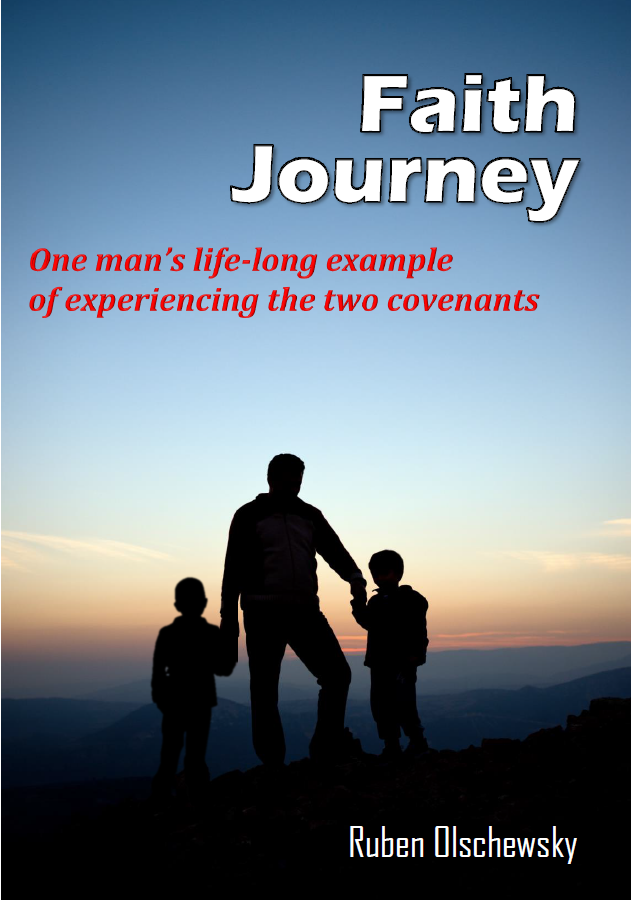(Deuteronomy 32:39) Why Does God Say, “I Kill, and I Make Alive”?
“See now that I, even I, am He, and there is no god with Me: I kill, and I make alive; I wound, and I heal: neither is there any that can deliver out of My hand." (Deuteronomy 32:39)
One of the ways that Christians have tried to address the violence seeming to come from God in the Old Testament is through an understanding of the Old and New Covenant. Many Christians teach that the Old Covenant relates only to the Old Testament Scriptures, or the period before Christ came to this earth and died on the cross. It was the era of the Law where you must “obey and live,” or disobey and die. There is also a sense that people in the Old Testament were really primitive in their mentality and could only understand the language of violence in dealing with crisis situations.
In contrast, the New Testament is perceived as an era of grace. The love of God is now revealed in Christ, and the gift of the Holy Spirit that came at that time allows men to experience the gospel. Those in the Old Testament could only dream of a future reality of a gospel beyond their reach. Some readers of Scripture have perceived this as God trying to do things in one way only to see it fail, and then try a more loving approach. Others present the situation as God simply doing the best He could under the circumstances until the Messiah would arrive. This only raises the question of why did it take so long for Christ to come into the world? Some reason that it would have been better to send Him earlier to introduce the loving approach sooner.
This approach to the Old and New Covenants presents two opposing principles to the plan of salvation. The Old Covenant focuses on Law enforcement while the New Covenant focuses on mercy.

The placing of the two principles in different eras of world history ensures that the Covenants are understood as opposing each other. Whereas, when these two principles are placed together in a sequence within a person’s personal experience, they reveal a beautifully divine process of restoration.
 Let us take for example the situation of a person that has some level of abnormal bone growth. Upon visiting the doctor the patient is informed that the doctor must break the bone and reset it to grow in the right way. What if the doctor only did the first part of the healing process? What if he only broke the bone and then left it? The doctor would be considered a terribly incompetent physician. Consider another person visiting the dentist due to a growing sense of pain in his mouth. The dentist discovers a serious case of tooth decay. With the consent of the patient he begins to drill out the tooth to prepare it to be restored. Sometimes the patient can experience considerable pain in this process. What if the dentist only did the first part of the job? If he only drills out the decay and lets the patient go home, the unprotected tooth will only continue to cause pain. Thus the dentist will be considered negligent because he only did the first half of the repair process.
Let us take for example the situation of a person that has some level of abnormal bone growth. Upon visiting the doctor the patient is informed that the doctor must break the bone and reset it to grow in the right way. What if the doctor only did the first part of the healing process? What if he only broke the bone and then left it? The doctor would be considered a terribly incompetent physician. Consider another person visiting the dentist due to a growing sense of pain in his mouth. The dentist discovers a serious case of tooth decay. With the consent of the patient he begins to drill out the tooth to prepare it to be restored. Sometimes the patient can experience considerable pain in this process. What if the dentist only did the first part of the job? If he only drills out the decay and lets the patient go home, the unprotected tooth will only continue to cause pain. Thus the dentist will be considered negligent because he only did the first half of the repair process.
Let’s see what is written in Scripture. Note carefully the use of the word “and” when underlined. This indicates both actions, the one before and after, are done together in sequence. It's not meant to be one or the other:
“See now that I, even I, am He, and there is no god with Me: I kill, and I make alive; I wound, and I heal: neither is there any that can deliver out of My hand." (Deuteronomy 32:39)
“The LORD killeth, and maketh alive: He bringeth down to the grave, and bringeth up. The LORD maketh poor, and maketh rich: He bringeth low, and lifteth up.” (1 Samuel 2:6-7)
“Who also hath made us able ministers of the new testament; not of the letter, but of the Spirit: for the letter killeth, but [or, and] the Spirit giveth life.” (2 Corinthians 3:6)
Take note in that last passage I inserted the word "and" suggesting that it should take the place of the word "but." The Greek word here is δέ (de) which can mean words such as "but, and, or now." Strong’s Concordance explains that it is a primary particle that can be “adversative or continuative.” Here's how that phrase appears in a few other translations:
Literal Standard Version: "... for the letter kills, and the Spirit makes alive."
Young's Literal Translation: "... the letter doth kill, and the spirit doth make alive."
Smith's Literal Translation: "... for the letter kills, and the Spirit makes alive.”
In each of these cases God is not killing some people over here, while healing and restoring some other people over there. Instead, the Bible is revealing a two-step process performed on the same individual. Firstly there is a diagnosis of the extent of the problem and a revelation of how painful it is. Secondly there is provided the remedy and restoration. This is how the covenants work in every person’s life. Here's how the book of Job explains the same process which is happening to one individual:
“Behold, happy is the man whom God correcteth: therefore despise not thou the chastening of the Almighty: For He maketh sore, and bindeth up: He woundeth, and His hands make whole." (Job 5:17, 18)
Here's another example referring to God's corporate people:
“Come, and let us return unto the LORD: for He hath torn, and He will heal us; He hath smitten, and He will bind [bandage] us up.” (Hosea 6:1)
This concept is beautifully revealed in the life of Abraham and Sarah. Their lack of faith was slowly being revealed. Paul reveals that Abraham’s connection to the two women, Sarah and Hagar, displays the truth of how the two covenants work:
“For it is written that Abraham had two sons: the one by a bondwoman, the other by a freewoman. But he who was of the bondwoman was born according to the flesh, and he of the freewoman through promise, which things are symbolic. For these are the two covenants: the one from Mount Sinai which gives birth to bondage, which is Hagar—for this Hagar is Mount Sinai in Arabia, and corresponds to Jerusalem which now is, and is in bondage with her children—but the Jerusalem above is free, which is the mother of us all.” (Galatians 4:22-26, New King James Version)
Abraham was married to both women. Hagar produced a child first but this caused Abraham so much pain to the point he was forced to send Hagar and his son away. The pain of this process showed Abraham the suffering that his lack of faith had caused. Then Abraham was able to move fully into the New Covenant experience. It was a two-step process with some overlap between the two covenants as there was a period when both sons were living in the same home. Through the test of offering up his son Isaac, Abraham was finally able to pass through into the New Covenant. His faith in the Lord did not waver. The perfection of his faith brought in him the restoration that God desired from the beginning. In order to do this work of restoration, the Lord had to allow the time process to expose Abraham’s disease of lacking faith in order to heal him. The Lord allowed events to play out that killed Abraham’s old way of thinking and raised him into the certainty of righteousness by faith. (Please see the article entitled, Why Did God Command Abraham to Sacrifice Isaac? for more details on this).
 Doctors use x-ray as an instrument to show us problems that exist in places we cannot see visibly with the naked eye. The Law of God acts as an instrument, a mirror to reveal the extent of our sin disease. This mirror is the tool that leads us to Christ if we accept the diagnosis.
Doctors use x-ray as an instrument to show us problems that exist in places we cannot see visibly with the naked eye. The Law of God acts as an instrument, a mirror to reveal the extent of our sin disease. This mirror is the tool that leads us to Christ if we accept the diagnosis.
“Wherefore the Law was our schoolmaster to bring us unto Christ, that we might be justified by faith.” (Galatians 3:24)
Sin is a problem that begins in the carnal mind. In order to fix this problem our Father in heaven must reveal to us our false thinking. This work is done through the Law.
“Moreover the Law entered, that the offence might abound. But where sin abounded, grace did much more abound.” (Romans 5:20)
The problem we have as humans is that, when the Lord begins to reveal to us our sinfulness, our natural mind pushes the problem back onto Him. Sarah stated that the Lord had restrained her from having a baby. She suggested it was His fault as to why things were not working. When the Lord asked Adam if he ate of the fruit of the tree, Adam pushed the blame back onto God.
“And He said, Who told thee that thou wast naked? Hast thou eaten of the tree, whereof I commanded thee that thou shouldest not eat? And the man said, The woman whom Thou gavest to be with me, she gave me of the tree, and I did eat.” (Genesis 3:11-12)
The reality of our nature has been gloriously contrasted to us in the life of Jesus. The love and mercy He showed to His enemies and His patient caring ministry completely condemns our selfishness. Rather than repent, the human heart projects these carnal attributes back onto God in order to justify its own sinfulness. James explains that the natural man reads the Word of God and sees his own natural face:
“For if anyone is a hearer of the word and not a doer, he is like a man observing his natural face in a mirror.” (James 1:23, New King James Version)
The Lord is acting like a doctor or dentist in how He is trying to show us the extent of the problem. In distress to Himself He repeatedly watches man go through the Old Covenant motions of salvation by his own ways, pleading to us that we recognize that we can only deal with the problem by allowing Christ to work in our hearts.
Sadly, since the fall of humanity, our hearts by nature are deceitful and murderous. When the natural man reads the Bible he projects these evil attributes onto God. When God is perceived to be violent and tyrannical by the reader this serves to fully reveal and expand the seeds that already had existed in the reader’s heart. As Paul explains:
“What shall we say then? Is the Law sin? God forbid. Nay, I had not known sin, but by the Law: for I had not known lust, except the Law had said, Thou shalt not covet. But sin, taking occasion by the commandment, wrought in me all manner of concupiscence. For without the Law sin was dead. For I was alive without the Law once: but when the Commandment came, sin revived, and I died. And the Commandment, which was ordained to life, I found to be unto death. For sin, taking occasion by the Commandment, deceived me, and by it slew me. Wherefore the Law is holy, and the Commandment holy, and just, and good. Was then that which is good made death unto me? God forbid. But sin, that it might appear sin, working death in me by that which is good; that sin by the Commandment might become exceeding sinful.” (Romans 7:7-13)
 Men use the stories of the Old Testament that appear to say God destroys and kills people to validate their own murderous nature. The Bible is carefully written to allow men to fully reveal what is in their hearts. The life of Jesus on earth shows us exactly what God is like (John 14:9). Jesus never killed anyone, but rather than look into this perfect mirror of God’s love, men choose to read the Old Testament as hearers of the word and they only see their own face on what they think is the face of God.
Men use the stories of the Old Testament that appear to say God destroys and kills people to validate their own murderous nature. The Bible is carefully written to allow men to fully reveal what is in their hearts. The life of Jesus on earth shows us exactly what God is like (John 14:9). Jesus never killed anyone, but rather than look into this perfect mirror of God’s love, men choose to read the Old Testament as hearers of the word and they only see their own face on what they think is the face of God.
The attempt to separate this two-step process presents God in the Old Testament as simply breaking bones and drilling teeth without any remedy for them. This makes God look harsh and cruel. Worse still is that the gospel people teach today is often simply believe in Jesus and don’t worry about your deformed bones and rotten teeth. This gospel would have Jesus just fill your cavities without cleaning out the decay. This separation of the two steps within a person’s life makes God look harsh in the Old Testament and soft and compromising in the New Testament. The greatest casualty of not understanding this two-step process correctly is that when God allows things to develop to reveal sin in those He is seeking to save, these manifestations of sin are attributed to God as His desire. For example: Did God command the killing of innocent babies to further the righteous work He desired, or did He command these things to bring out our own sinful desires deep within ourselves? How would you respond if God told you to kill someone who hated God and Christians? We need to understand God's true character and the intent of His "command" in order to respond correctly. For more info on this, see the article entitled: Didn’t God Command the Israelites to Slaughter Men, Women, and Children With the Sword?
When the Law enters our hearts and minds it causes the sin in us to abound and become more visible. We are then invited to turn to Christ and receive the Remedy.
“For Christ is the end-objective of the Law for righteousness to everyone that believes.” (Romans 10:4)
“Knowing this, that our old man is crucified with him, that the body of sin might be destroyed, that henceforth we should not serve sin. For he that is dead is freed from sin. Now if we be dead with Christ, we believe that we shall also live with Him: Knowing that Christ being raised from the dead dieth no more; death hath no more dominion over Him. For in that He died, He died unto sin once: but in that He liveth, He liveth unto God. Likewise reckon ye also yourselves to be DEAD indeed unto sin, but (or, and) ALIVE unto God through Jesus Christ our Lord.” (Romans 6:6-11)
For a deeper understanding to what you have just read, see the books entitled: The Conviction of Sin and Righteousness, and Faith Journey.
For a printed copy of this study in booklet form, see What Does God Mean When He Says "I Kill & I Make Alive"



.png)

